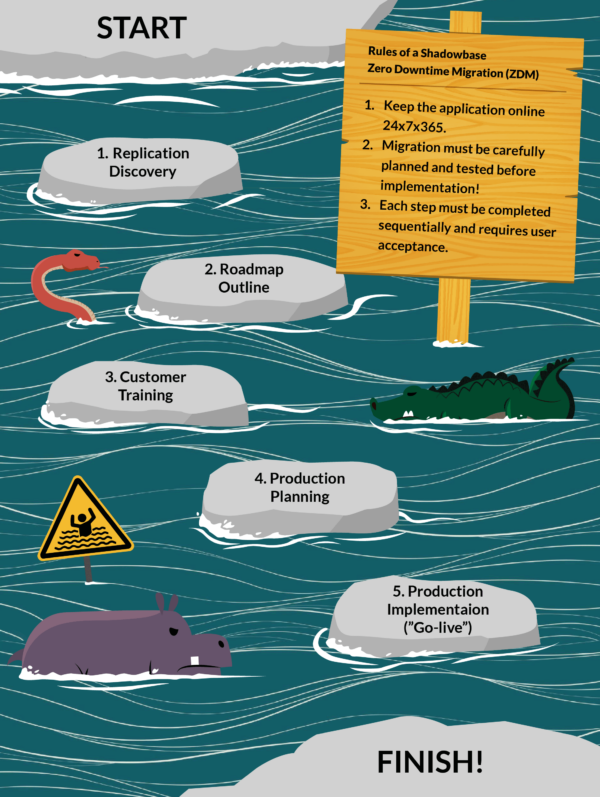Project Deployment Steps

Customers often ask us, What is involved in deployment of a Shadowbase project?
We created this outline to help define the steps involved in such a project. Please note that this outline is not all-inclusive, and specific customer situations will demand a more customized response. Therefore, the most common steps in a Shadowbase deployment are outlined here.
- Replication Discovery
- Meet with the customer to determine the types of applications that are run and the types of replication that are required, such as:
- Application Integration – feed database changes from one application into another application (typical use – “real-time business intelligence”)
- Business Continuity – provide high and continuous availability for your data (for example, active/passive disaster recovery, sizzling-hot-takeover, and active/active disaster tolerant architectures)
- Data Integration – feed database changes from one application into another database (for example, feed a data warehouse)
- Data Validation – ensure database consistency via Shadowbase Compare
- Essentials – know and record your transactions, convert and map files and table structures, flexibly transform data, restore corrupted databases, automatically replicate and apply DDL commands, extract database changes or initial load data into Flat Files
- Utilities – EOF (end-of-file) chasing, SOLV (Shadowbase Online Loading and Verification) database snapshot loads, and the Queue Manager for queuing change data
- Discuss the platforms and environments that are used (e.g., HPE NonStop only or Other Servers also, such as Linux, Windows, etc.), and the databases that are replicated (NonStop-based, and/or Other Servers such as Oracle, SQL Server, IBM Db2®, etc.)
- Replication Details
- Drill down into the details for each replication type. Determine the desired recovery time objective (RTO) and recovery point objective (RPO) for each application, which helps define the replication architecture and technology to use
- For all needs, determine the replication technology that is required
- Asynchronous (some data loss can occur at failure)
- Synchronous (no data loss at failure)
- For business continuity, determine the architecture
- Active/active
- Sizzling-hot-takeover
- Active/passive
- For data integration, determine the details about the source to target data formats and environments
- For application integration, determine the details about the source to target data formats and environments
- Solution Architecture
- Architect the solution and prepare the project plan
- Determine if other HPE products are needed
- AutoTMF if replicating non-audited NonStop Enscribe data
- AutoSYNC if replicating non-database NonStop files, such as program code files, script files, or edit files
- See also: carrscott.com/nonstop-autosync/
- Determine the Shadowbase detailed steps for each form of replication based on the selected architecture
- Install into each environment
- Configure for each environment
- Implement/configure data mappings, transformations, and other manipulations (if needed)
- Test and rework/retest
- Customer Training
- Usually occurs early in the sequence as a hands-on process, prior to the customer’s involvement in the project steps (assuming involvement is needed)
- More formal training often occurs prior to production rollout for remainder of the systems and operations staff
- More detailed training agenda
- Production Planning
- Formal training before production
- QA certification/pre-production certification testing (assuming the customer wants to conduct this step)
- Installation/configuration/deployment into production environments
- Production Implementation
- Begins one/two days prior to the actual go-live date, to allow for verifying the final configuration and rollout steps
- Completes one/two days past the go-live date, to allow time for verifying that the rollout was properly implemented
- Project (Step) Acceptance
- Required at each step, occurring throughout project planning and execution
- Project can be terminated or adjusted as necessary (with mutual agreement) at any step if customer’s defined criteria/needs are not met
- Onsite vs Offsite
- As part of the project plan, and based on the customer’s needs/desires, various parts of the project may be performed remotely (offsite), at the customer’s facilities (onsite), or a combination of both. Typically, the initial discussions/discovery process is performed onsite, subsequent work is performed either remotely or onsite, and the final training and deployment are often performed onsite. However, each customer defines how and where the contracted services are provided.
- Since onsite services include travel and living expenses, sufficient advance scheduling is necessary to minimize travel costs.
For additional information, HPE Shadowbase manuals are posted on the HPE NonStop Technical Library.
